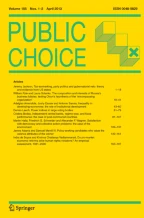Abstract
All positional voting procedures can be manipulated, so it is natural to question whether some of these systems are more susceptible to being manipulated than others. In this essay, this susceptibility factor is measured for strategic action involving small groups. It is shown that the system least susceptible to micro manipulations for n = 3 candidates is the Borda Count (BC). The optimal choice changes with n, but the analysis shows that the BC always fares fairly well. On the other hand, the plurality and anti-plurality vote as well as multiple voting systems, such as approval voting and cumulative voting, always fare quite poorly with respect to susceptibility. Finally, it is shown why it is possible to justify any voting method by choosing an appropriate measure of susceptibility and imposing the appropriate assumptions on the profiles of voters. This statement emphasizes the importance of the basic assumptions of neutrality used throughout this essay.
Similar content being viewed by others
References
Brams, S. and Fishburn, P. (1984). Manipulability of voting by sincere truncation of preferences. Public Choice 44: 397–410.
Chamberlin, J. (1985). Investigation into the relative manipulability of four voting systems. Behavioral Science 30: 195–203.
Gibbard, A. (1973). Manipulation of voting schemes: A general result. Econometrica 41: 587–602.
Meyerson, R. (1988). Mechanism design. In J. Eatwell, Milgate and P. Newman (Eds.), Allocation, information, and markets.
Niemi, R. (1984). The problem of strategic behavior under approval voting. American Political Science Review 78: 952–958.
Nitzan, S. (1985). The vulnerability of point-voting schemes to preference variation and strategic manipulation. Public Choice 47: 349–370.
Riker, W.H. (1982). Liberalism against populism. San Francisco: W.H. Freeman.
Saari, D.G. (1989a). A dictionary for voting paradoxes. Journal of Economic Theory.
Saari, D.G. (1989b). The Borda dictionary. NU Center for Mathematical Economics, Discussion paper #821, Northwestern University, Evanston, IL.
Saari, D.G. and van Newenhizen, J. (1988a). The problem of indeterminancy in approval, multiple, and truncated voting systems. Public Choice 59: 101–120.
Saari, D.G. and van Newenhizen, J. (1988b). Is approval voting an ‘unmitigated evil’: A response to Brams, Fishburn, and Merrill. Public Choice 59: 133–147.
Satterthwaite, M. (1975). Strategy-proofness and Arrow's conditions: Existence and correspondence theorem for voting procedures and social welfare functions. Journal of Economic Theory 10: 187–217.
Sawyer and MacRae (1962). Game theory and cumulative voting in Illinois: 1902–1954. American Political Science Review 56: 936–946.
Author information
Authors and Affiliations
Additional information
This research was supported, in part, by NSF grants IRI-8415348, IRI-8803505, and a Fellowship from the Guggenheim Memorial Foundation. Also, I would like to thank P. Aranson for his several helpful comments.
Rights and permissions
About this article
Cite this article
Saari, D.G. Susceptibility to manipulation. Public Choice 64, 21–41 (1990). https://doi.org/10.1007/BF00125915
Issue Date:
DOI: https://doi.org/10.1007/BF00125915
